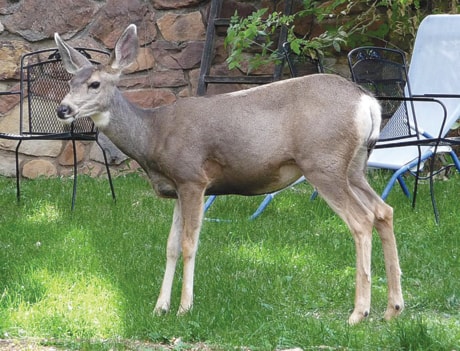When we think of moose, deer or elk we conjure up pictures of majestic animals traipsing through the untouched wilderness.
Unfortunately, for many gardeners the animals that are fascinating to watch in the wilderness are very destructive in a garden.
These animals do not understand the time, money and energy that are put into gardens.
Instead they look at it as a tasty, free lunch. A quick nibble could be understood but large animals are not dainty eaters which results in permanent damage such as broken limbs and torn bark.
During the growing season trees and shrubs are largely ignored as the ground cover is lush and tasty but as the snow grows deeper the animals turn to browsing.
Protecting the garden during the cold months when there is often little human interaction is important.
The best way to protect the plants is to keep the animals out of the garden.
For many, it is impossible, expensive and impractical. The only guaranteed method is a deer fence. While this will work in rural areas towns have by-laws prohibiting tall fences.
Plants then need to be protected individually. One methods is to wrap the tree or shrub in chicken wire or plastic snow fencing. The animals can only eat what is sticking through the holes in the fence. As the material will be visible in the garden for a number of months, choose a colour that will enhance or blend into the landscape. Erecting a fence around all trees and shrubs can also be effective. The fence must be back far enough that the animal can not lean forward and eat the plants. The enclosure must also be small enough that the animal will not hop the fence as it will have enough room to get back out.
There are bitter tasting sprays on the market that will discourage browsing. The sprays will work for a time but they need to be reapplied regularly. Bad taste is not a match for hunger which means that the method is not fool proof.
Small animals such as mice and rabbits are also very destructive especially with young plants. These animals do not attack the tips; they remove the bark at the base of the plant.
Nutrients flow to all parts of the plant through the bark and a hole will slow down the process. If the plant is girdled, a ring of bark is removed, the branch can not receive nutrient and it will die.
This is the method that earlier settlers used to clear the land in Eastern Canada.
Young plants are the most vulnerable as their bark is thinner and more succulent. Tree guards can be placed around the trunks of young trees, putting a barrier between the bark and animals teeth. The same can not be done with shrubs.
Keeping the grass trimmed around the base of trees and shrubs is also effective.
Small animals are less likely to dine on a plant when they themselves are exposed to their predators. Trampling the snow down around these plants removes all under covered access during the winter months.
Often the yard is too big or the plants too numerous to protect every one. When this is the case choices must be made. Criteria will vary but size, variety and placement of the plants are important. Large trees are expensive to replace. Animals will usually eat fruit baring plants over ornamentals. Animals that are leery will not go into a secluded area with only one entrance. Taking time to protect plants when the weather is relatively mild can make a huge difference next spring. It is very discouraging to see carefully planted and cared for trees and shrubs ruined.
Linda Tomlinson is a horticulturalist and educator living in Rocky Mountain House. You can contact her at your_garden@hotmail.com.
